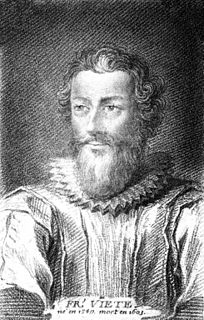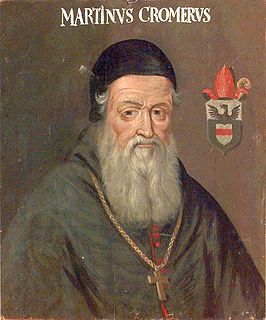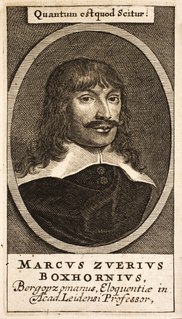Related Research Articles

Pope Adrian VI, born Adriaan Florensz Boeyens, was head of the Catholic Church and ruler of the Papal States from 9 January 1522 until his death on 14 September 1523. The only Dutchman to become pope, he was the last non-Italian pope until the Polish John Paul II 455 years later.

Willebrord Snellius was a Dutch astronomer and mathematician, known in the English-speaking world as Snell. In the west, especially the English speaking countries, his name is attached to the law of refraction of light.

Girolamo Fabrici d'Acquapendente, also known as Girolamo Fabrizio or Hieronymus Fabricius, was a pioneering anatomist and surgeon known in medical science as "The Father of Embryology."

François Viète, Seigneur de la Bigotière was a French mathematician whose work on new algebra was an important step towards modern algebra, due to its innovative use of letters as parameters in equations. He was a lawyer by trade, and served as a privy councillor to both Henry III and Henry IV of France.
Adriaan van Roomen, also known as Adrianus Romanus, was a mathematician, professor of medicine and medical astronomer from the Duchy of Brabant in the Habsburg Netherlands who was active throughout Central Europe in the late 16th and early 17th centuries. As a mathematician he worked in algebra, trigonometry and geometry; and on the decimal expansion of π. He solved the Problem of Apollonius using a new method that involved intersecting hyperbolas. He also wrote on the Gregorian calendar reform.

Marcin Kromer was Prince-Bishop of Warmia (Ermland), a Polish cartographer, diplomat and historian in the Kingdom of Poland and later in the Polish–Lithuanian Commonwealth. He was a personal secretary to two Kings of Poland, Sigismund I the Old and Sigismund II Augustus.

Simon Episcopius was a Dutch theologian and Remonstrant who played a significant role at the Synod of Dort in 1618. His name is the Latinized form of his Dutch name Simon Bisschop.

Marcus Zuerius van Boxhorn was a Dutch scholar. Born in Bergen op Zoom, he was professor at the University of Leiden. He discovered the similarity among Indo-European languages, and supposed the existence of a primitive common language which he called 'Scythian'. He included in his hypothesis Dutch, Greek, Latin, Persian, and German, later adding Slavic, Celtic and Baltic languages. He excluded languages such as Hebrew from his hypothesis. He died in Leiden.

Adriaan van den Spiegel, name sometimes written as Adrianus Spigelius, was a Flemish anatomist born in Brussels. For much of his career he practiced medicine in Padua, and is considered one of the great physicians associated with the city. At Padua he studied anatomy under Girolamo Fabrici.

Bonaventura Vulcanius was a Flemish humanist who played a leading role in Northern humanism during the 16th and 17th century. He was a professor of Latin and Greek at Leiden University for 30 years and published various books in the Latin language. He was also a poet.

Anselmus de Boodt or Anselmus Boëtius de Boodt was a Flemish humanist, mineralogist, physician and naturalist. Along with the German known as Georgius Agricola, de Boodt was responsible for establishing modern mineralogy. De Boodt was an avid mineral collector who travelled widely to various mining regions in Germany, Bohemia and Silesia to collect samples. His definitive work on the subject was the Gemmarum et Lapidum Historia (1609).

Aubert le Mire, Latinized Aubertus Miraeus was an ecclesiastical historian in the Spanish Netherlands.
Jan Łasicki was a Polish historian and theologian. He was well-educated and traveled extensively in Western Europe from 1556 to 1581. Around 1557 he converted to Calvinism, becoming a follower of the Unity of the Brethren after 1567.

Adolf van Meetkercke (1528–1591) was a Flemish diplomat and humanist.
Nicolaus Vernulaeus (1583–1649) was a professor at the University of Leuven and an important Neo-Latin playwright.

Jacob Cruucke or Jacob van Cruyck, also known by his Latinized name Jacobus Cruquius and in French-language literature as Jacques de Crucque was a Flemish humanist, philologist, and scholar of the 16th century. He is mainly known for his publications on the works of the Roman lyric poet Horace based on ancient manuscripts kept in the library of a local monastery, since lost to fire.
Franciscus Portus was a Greek-Italian Renaissance humanist and classical scholar.

Frans van Cranevelt, also known as Franciscus Craneveldius, was a Flemish humanist and lawyer.
Adrianus van der Burch or Vanderburchius was a Latin poet in the Dutch Republic.
Bartolomeo Beverini was an Italian classical scholar and historian.
References
- ↑ Joseph Vercoullie, "Schrieck, Adrien Van", Biographie Nationale de Belgique , vol. 22 (Brussels, 1920), 38-39.
- ↑ Lincy, Le Roux de (1907). Researches Concerning Jean Grolier: His Life and His Library. Grolier club. Retrieved 9 April 2017.